Getting Around Helsinki

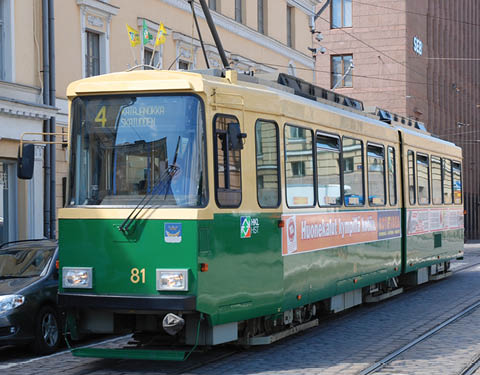
Tram cars are an economical way to visit city attractions.
There are numerous piers in Helsinki servicing cruise ships as well as local ferries to Stockholm and Tallinn. The Munkkisaari quays at Hernesaari are located about 2 miles (3 km) west of the city centre. It’s a pleasant 30-minute walk into town from Hernesaari along the park-lined waterfront or through the upscale neighbourhood of Eira and the shop-filled Design District. Some cruise ships docking at Hernesaari will provide a shuttle that drops off near the Swedish Theatre.
If there’s no shuttle, one option is to catch the public bus (#14) along Hernesaarenranta and get off at one of the stops along Fredrikinkatu (the fare is 3 euros). The red Hop-On Hop-Off bus sometimes stops at the cruise pier or can be boarded at Eira as it follows a circular route from Senate Square to the city’s major attractions (25 euros). The taxi fare from Munkkisaari pier to Market Square is about 12 euros.
A tourist information booth is located at the Munkkisaari cruise pier. The Helsinki City Card, which is sold online (36 euros) and at locations throughout the city, provides free admission to top attractions and public transport.
The other cruise piers are located in the South Harbour in front of the Olympia Terminal (a 10-minute walk into the city centre) and at Pakkahuone Quay (a five-minute walk to Market Square).
The city core can be explored on foot or hop aboard Tram 2 (formerly Tram 3T) at its stop near the Olympia Terminal to travel the “sightseeing route” past the major attractions to the Olympic Stadium and back. You can get on or off the tram at any stop, or complete the entire loop in about an hour. Tram tickets are valid for one hour and can be purchased from the driver; the cost is 3 euros.
The Helsinki Tourist & Convention Bureau is located near the east end of the Esplanade, at Pohjoisesplanadi 19.

Finnish handicrafts are sold at Market Square.
Finnish design is highly regarded and has been successfully applied to clothing, jewellery, tableware and furniture. The famous glassware manufacturer Iittala, founded in 1881, carries an extensive line of classic and contemporary works, including its signature Aalto vase. Iittala’s flagship store is on the north side of Esplanade at Pohjoisesplanadi 25. Other items designed by Alvar Aalto can be found at Artek, also on the Esplanade (Etelaesplanadi 18).
Finnish textiles are recognizable for their bold and colourful prints, exemplified by the innovative creations of Ritta Immonen who co-founded Marimekko in Helsinki in 1951. The sleeveless, cotton dresses designed by Marimekko were elevated to international status when Jackie Kennedy wore several during the 1960 U.S. presidential campaign. Marimekko shops are located at the west end of the Esplanade (Pohjoisesplanadi 2) and in the Kamp Gallery (beside the Hotel Kamp on the north side of the Esplanade).
Finnish designer products are featured at Design Forum Finland, located a few blocks south of the Esplanade in Helsinki’s Design District – home to antique shops, interior decorating studios, and clothing and jewellery boutiques.
Helsinki’s main shopping streets are Mannerheimint, Aleksanterinkatu and both sides of the Esplanade. Stockmann is Helsinki’s largest department store (occupying the entire block at the corner of Aleksanterinkatu and Mannerheimint) and carries an enormous selection of items.
The recently revitalized Tori Quarters (the neoclassical city blocks between Market Sq. and Senate Sq.) contain design and craft shops, including the latest fashions at Kiseleff House on the south side of Senate Square.
One of the best places to browse for Finnish handicrafts, ceramics, textiles, jewellery and toys is at Market Square where local artisans set up outdoor tables to display their wares. Alongside Market Square stands Old Market Hall where specialty food shops sell Finnish coffee, cheeses, sweets and tinned delicacies.
For information on claiming VAT returns on purchases worth a minimum total of 40 euros, see www.globalrefund.com. To browse online for Finnish design products, visit finnishdesignshop.com.

Sofiankatu leads past sidewalk cafes to Senate Square.
Finns traditionally dined on simple food that was available during the long winters, such as game meat, root vegetables and smoked or pickled fish. Today Finnish cuisine features fresh seafood and sauces flavoured with garden herbs. Numerous cafés line the Esplanade, including the glass-roofed Café Kappeli, which has been a favourite Helsinki gathering place since it opened in 1867, and which remains the place to pause for a light lunch. The bar serves European beers on tap and wines by the glass.
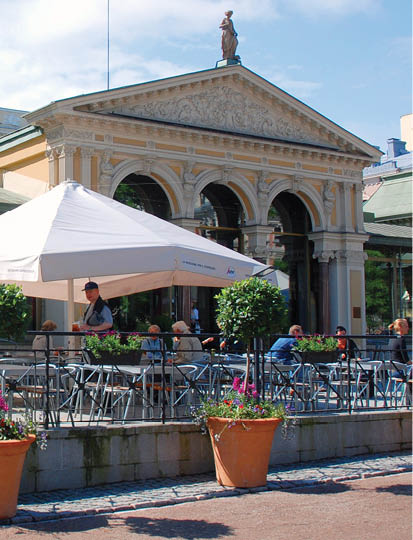
Cafe Kappeli.
The luxurious Hotel Kamp, which opened in 1887 on the north side of the Esplanade at Pohjoisesplanadi 29, serves a lavish afternoon tea, while the cozy Café Esplanade at Pohjoisesplanadi 37 serves delicious cinnamon rolls, and soup and sandwiches at lunch time. The seaside Café Ursula at Embassy Park is a pleasant spot to pause for refreshment on the large terrace if you’re walking to or from Hernesaari cruise port.

The Esplanade.
1. Esplanade – The cruise ships’ shuttle drops off passengers near the Swedish Theatre at the western end of the Esplanade, a broad boulevard that runs down to the harbourfront and serves as the social hub of Helsinki. Outdoor cafes and design shops line both sides, and running down the middle is a narrow park lined with linden trees where locals and tourists gather to watch the buskers or relax on park benches.
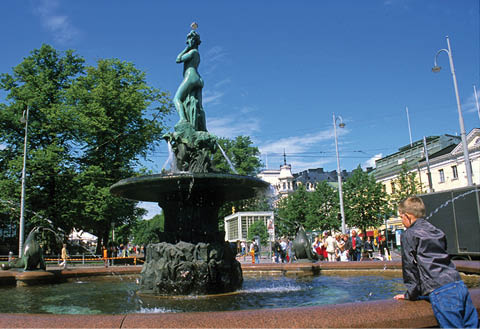
Havis Amanda.
The Havis Amanda Fountain, located near the eastern end of the Esplanade, features a centrepiece bronze sculpture of a young woman symbolizing Helsinki’s rebirth. Each spring on the eve of May Day she is washed by university students while thousands of onlookers gather to watch this fun-filled ritual.
Map of Helsinki
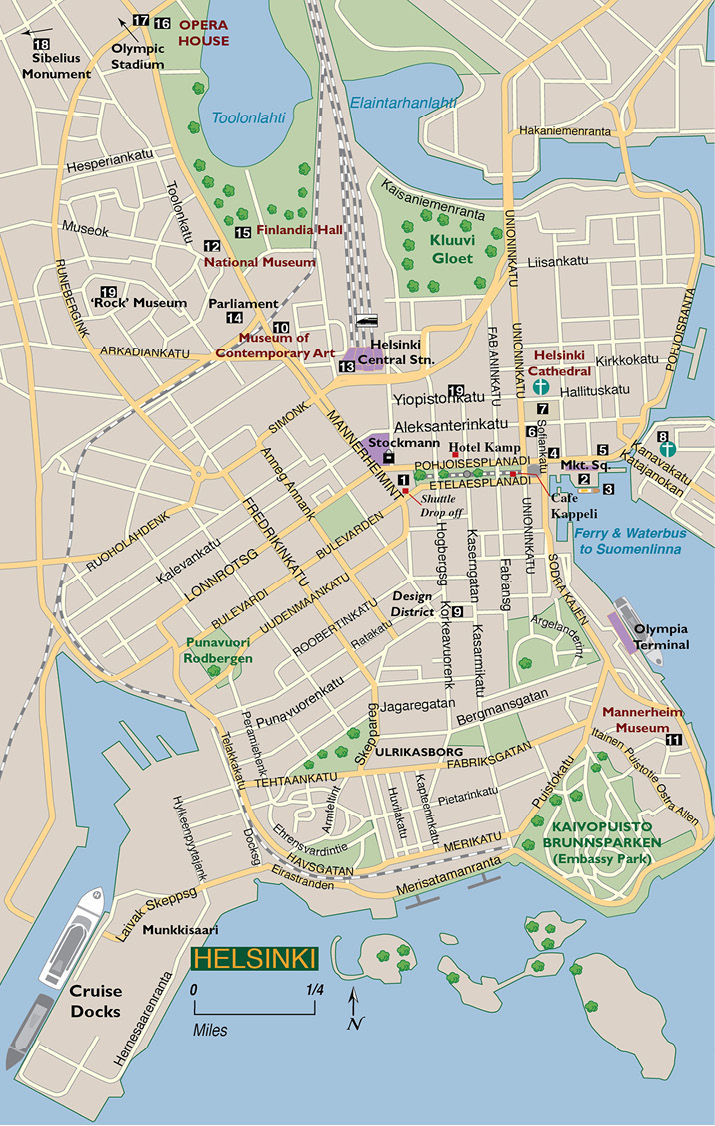
2. Market Square – Lies at the harbourfront end of the Esplanade and is where local artisans set up tables displaying their wares.
3. Suomenlinna Sea Fortress – Sightseeing boats and passenger ferries to Suomenlinna Sea Fortress (a 15-minute trip) depart from piers beside Market Square. Suomenlinna is a UNESCO World Heritage Site and is situated on six islands connected by bridges. Visitors can join guided tours or independently explore the 18th-century fortifications (including many tunnels). The historic maritime fortress also features numerous museums, shops and cafes.
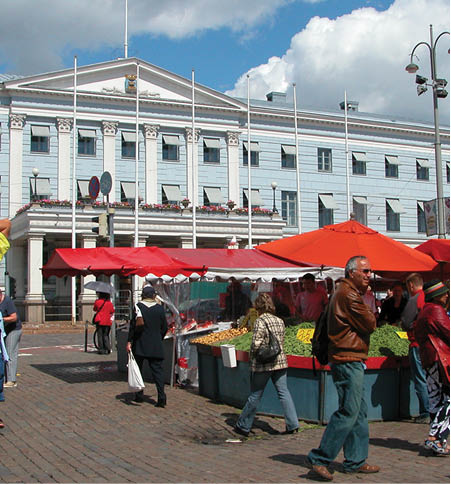
City Hall
4. City Hall – Originally built as a hotel in 1833, the City Hall overlooks Market Square (the mayor’s office is located above the large balcony).
5. Presidential Palace – Located two blocks east (entrance allowed only as part of a guided tour); once used by the Russian czar, it is now a venue for presidential functions.

The main University building.
6. City Museum – Sofiankatu leads north past the City Museum.
7. Senate Square – Where Helsinki’s landmark cathedral looms above the neoclassical buildings surrounding the monumental centre of Helsinki. The Prussian-born architect Carl Ludvig Engel, who had trained in Berlin before working abroad in various cities including St. Petersburg, was chosen by Czar Alexander I to design a civic square in keeping with Helsinki’s new role as capital of the Grand Duchy of Finland. The Palace of the Council of State was completed on the eastern side of Senate Square in 1822 and the main University building, on the opposite side of the square, was completed 10 years later. Beside it is the National Library.
The Church of St. Nicholas (now Helsinki Cathedral) was modelled after Saint Issac’s Cathedral in St. Petersburg’s Senate Square and was completed in 1852, twelve years after Engel’s death. Standing at the top of a broad but very steep flight of steps, the neo-classical Cathedral was built in the Greek-cross plan with a central dome and four smaller domes. A statue of Czar Alexander II stands at the bottom of the steps, the figures at the base of the pedestal representing the law, culture and peasantry. Senate Square is used for various public events, including outdoor concerts and snowboard happenings. It has also posed as a Russian square in such movies as Warren Beatty’s Reds (1981) and John Huston’s The Kremlin Letter (1970).

Uspenski Orthodox Cathedral
8. Uspenski Orthodox – Standing on a hilltop near the harbour, this Cathedral was designed by a Russian architect in the 1860s in the Russian Byzantine revival style. It is the largest Eastern Orthodox church in Western Europe and symbolic of Finland’s Russian connections with its golden cupolas and red-brick facade.
9. Design Museum – Helsinki is home to dozens of excellent museums, including the Design Museum (in the heart of the city’s Design District).
10. The Museum of Contemporary Art Kiasma – Housed in a contemporary building designed by American architect Steven Holl.
11. Mannerheim Museum – The Mannerheim Museum, which was the home of the military hero Baron Carl Gustav Emil Mannerheim, who led Finnish forces to independence in 1918 and later served as president of Finland.
12. The National Museum of Finland – This museum, which opened in 1916, is housed in a building designed in the national romanticist style by Eliel Saarinen. Its entrance hall is adorned with frescoes depicting the Kalevala – an epic poem compiled from Finnish folklore by the 19th-century writer Elias Lounrot.
13. Helsinki Central Railway Station – Designed by Eliel Saarinen, this railway opened in 1919. It represents the country’s architectural transition from National Romanticism to a Functionalist style. Its features include a clock tower, with much of the building clad in Finnish granite.
14. Parliament House – Home to Finland’s 200-seat parliament, this is an example of Nordic Classicism. Designed by J.S. Siren and completed in 1931, the building’s red granite facade features a row of Corinthian columns.
15. Finlandia Hall – Overlooking Toolonlahti Bay, this hall was designed by the legendary Finnish architect Alvar Aalto. Completed in 1975, this magnificent concert and meeting hall is an example of Modernism at its finest; 30-minute guided tours are available.
16. Finnish National Opera – Also standing on the shores of Toolonlahti Bay is the Finnish National Opera, its building completed in the 1990s.
17. The Olympic Stadium – built for the 1952 Olympic Games – is located near the north end of Toolonlahti Bay. The stadium’s Functionalist design includes a tower that is 72 metres high and provides spectacular views over the city. Nearby is the flower-filled Winter Garden.
18. The Sibelius Monument – Situated in Sibelius Park, which was named in 1945 to honour the 80th birthday of the composer Jean Sibelius. The monument itself, made of stainless steel tubes, is the work of Eila Hiltunen and was unveiled in 1967.
19. Temppeliaukio ‘Rock’ Church – One of Helsinki’s most unusual attractions, quarried out of the natural bedrock. Designed by Timo and Tuomo Suomalainen and constructed in 1969, the Rock Church is used both for religious services and as a venue for concerts with its excellent acoustics.